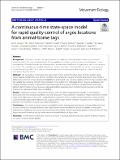Files in this item
A continuous-time state-space model for rapid quality control of argos locations from animal-borne tags
Item metadata
| dc.contributor.author | Jonsen, Ian D. | |
| dc.contributor.author | Patterson, Toby A. | |
| dc.contributor.author | Costa, Daniel P. | |
| dc.contributor.author | Doherty, Philip D. | |
| dc.contributor.author | Godley, Brendan J. | |
| dc.contributor.author | Grecian, W. James | |
| dc.contributor.author | Guinet, Christophe | |
| dc.contributor.author | Hoenner, Xavier | |
| dc.contributor.author | Kienle, Sarah S. | |
| dc.contributor.author | Robinson, Patrick W. | |
| dc.contributor.author | Votier, Stephen C. | |
| dc.contributor.author | Whiting, Scott | |
| dc.contributor.author | Witt, Matthew J. | |
| dc.contributor.author | Hindell, Mark A. | |
| dc.contributor.author | Harcourt, Robert G. | |
| dc.contributor.author | McMahon, Clive R. | |
| dc.date.accessioned | 2020-07-22T12:30:01Z | |
| dc.date.available | 2020-07-22T12:30:01Z | |
| dc.date.issued | 2020-07-17 | |
| dc.identifier | 269246721 | |
| dc.identifier | d64be6e3-9454-42ea-8899-ec530ba8ea3e | |
| dc.identifier | 85088640622 | |
| dc.identifier | 000552302200001 | |
| dc.identifier.citation | Jonsen , I D , Patterson , T A , Costa , D P , Doherty , P D , Godley , B J , Grecian , W J , Guinet , C , Hoenner , X , Kienle , S S , Robinson , P W , Votier , S C , Whiting , S , Witt , M J , Hindell , M A , Harcourt , R G & McMahon , C R 2020 , ' A continuous-time state-space model for rapid quality control of argos locations from animal-borne tags ' , Movement Ecology , vol. 8 , 31 . https://doi.org/10.1186/s40462-020-00217-7 | en |
| dc.identifier.issn | 2051-3933 | |
| dc.identifier.other | RIS: urn:4294EC30BE25A3BD1A81D92B3F88E643 | |
| dc.identifier.other | RIS: Jonsen2020 | |
| dc.identifier.other | ORCID: /0000-0002-6428-719X/work/77893814 | |
| dc.identifier.uri | https://hdl.handle.net/10023/20308 | |
| dc.description.abstract | Background State-space models are important tools for quality control and analysis of error-prone animal movement data. The near real-time (within 24 h) capability of the Argos satellite system can aid dynamic ocean management of human activities by informing when animals enter wind farms, shipping lanes, and other intensive use zones. This capability also facilitates the use of ocean observations from animal-borne sensors in operational ocean forecasting models. Such near real-time data provision requires rapid, reliable quality control to deal with error-prone Argos locations. Methods We formulate a continuous-time state-space model to filter the three types of Argos location data (Least-Squares, Kalman filter, and Kalman smoother), accounting for irregular timing of observations. Our model is deliberately simple to ensure speed and reliability for automated, near real-time quality control of Argos location data. We validate the model by fitting to Argos locations collected from 61 individuals across 7 marine vertebrates and compare model-estimated locations to contemporaneous GPS locations. We then test assumptions that Argos Kalman filter/smoother error ellipses are unbiased, and that Argos Kalman smoother location accuracy cannot be improved by subsequent state-space modelling. Results Estimation accuracy varied among species with Root Mean Squared Errors usually <5 km and these decreased with increasing data sampling rate and precision of Argos locations. Including a model parameter to inflate Argos error ellipse sizes in the north - south direction resulted in more accurate location estimates. Finally, in some cases the model appreciably improved the accuracy of the Argos Kalman smoother locations, which should not be possible if the smoother is using all available information. Conclusions Our model provides quality-controlled locations from Argos Least-Squares or Kalman filter data with accuracy similar to or marginally better than Argos Kalman smoother data that are only available via fee-based reprocessing. Simplicity and ease of use make the model suitable both for automated quality control of near real-time Argos data and for manual use by researchers working with historical Argos data. | |
| dc.format.extent | 1545029 | |
| dc.language.iso | eng | |
| dc.relation.ispartof | Movement Ecology | en |
| dc.subject | Animal-borne sensors | en |
| dc.subject | Bio-telemetry | en |
| dc.subject | foieGras R package | en |
| dc.subject | Global Positioning System | en |
| dc.subject | Seabird | en |
| dc.subject | Pinniped | en |
| dc.subject | Sea turtle | en |
| dc.subject | Template model builder | en |
| dc.subject | QH301 Biology | en |
| dc.subject | NDAS | en |
| dc.subject | SDG 14 - Life Below Water | en |
| dc.subject.lcc | QH301 | en |
| dc.title | A continuous-time state-space model for rapid quality control of argos locations from animal-borne tags | en |
| dc.type | Journal article | en |
| dc.contributor.institution | University of St Andrews. School of Biology | en |
| dc.contributor.institution | University of St Andrews. Scottish Oceans Institute | en |
| dc.contributor.institution | University of St Andrews. Sea Mammal Research Unit | en |
| dc.identifier.doi | https://doi.org/10.1186/s40462-020-00217-7 | |
| dc.description.status | Peer reviewed | en |
This item appears in the following Collection(s)
Items in the St Andrews Research Repository are protected by copyright, with all rights reserved, unless otherwise indicated.

